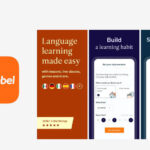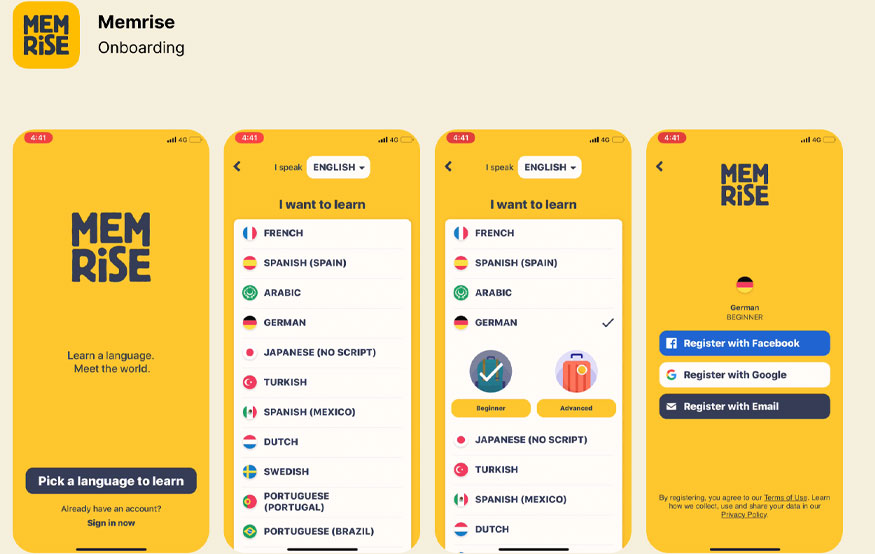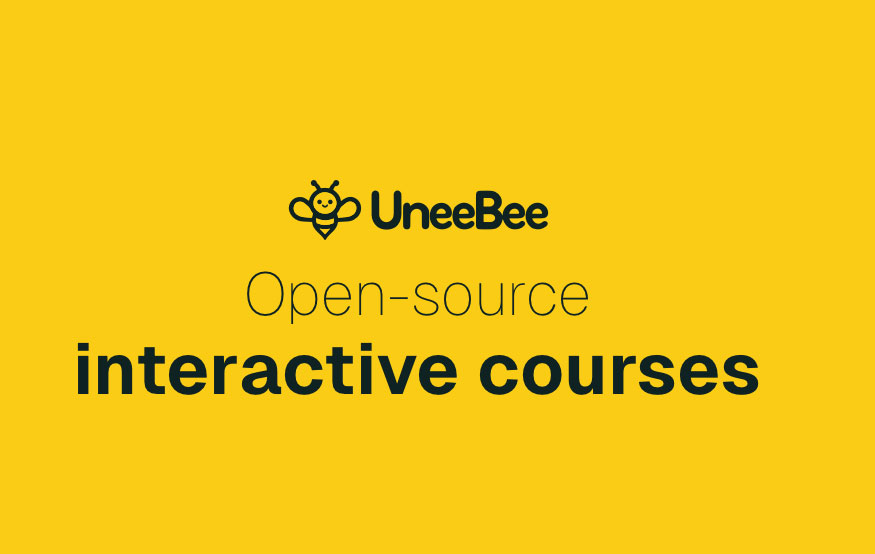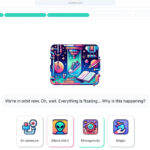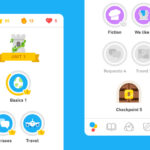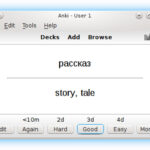Language Learning Tools: Revolutionizing Global Communication
The Evolution of Language Learning Tools
In today’s interconnected world, the ability to communicate across linguistic barriers has become more crucial than ever.
SORT
Learn why SEO Testing Tools is free?
SEO Testing Tools is free for users because vendors pay us when they receive web traffic and sales opportunities.
SEO Testing Tools directories list all vendors—not just those that pay us—so that you can make the best-informed purchase decision possible.
174.48K reviews
167.67K followers
- 94.04K users like this
- This launch happened 12 years ago
Babbel for Business offers personalized language learning tailored to your organization’s needs, enhancing employee skills. Its interactive courses improve communication, boost productivity, and foster inclusivity.
LICENSE MODEL
Paid
PRODUCT MODEL
Proprietary
PLATFORMS
- Online
- Android
- iPhone
- iOS
- Android Tablet
- iPad
- Apple Watch
Babbel for Business CATEGORIES ON SEOTESTINGTOOLS.COM
Babbel for Business FEATURES
- Language Learning
- Business Solutions
- Support & Resources
430.47K reviews
75.86K followers
- 456.63K users like this
- This launch happened 7 years ago
ELSA Speak offers personalized pronunciation coaching using AI technology. Its interactive exercises enhance speaking skills, boost confidence, and provide real-time feedback, making language learning effective and engaging.
LICENSE MODEL
Free
PRODUCT MODEL
Proprietary
PLATFORMS
- Android
- iOS
- iPhone
- iPad
- Android Tablet
- Online
ELSA Speak CATEGORIES ON SEOTESTINGTOOLS.COM
ELSA Speak FEATURES
- Speech Recognition
- Personalized Learning
- Engaging Content
- Mobile Compatibility
- Multi Device Support
- Multiple languages
- Community Features
- AI-Powered
- AI-Powered Scoring
492.74K reviews
238.58K followers
- 113.39K users like this
- This launch happened 15 years ago
Vocabulary.com offers an adaptive learning system that personalizes word challenges, a fast dictionary for quick definitions, and interactive exercises to boost vocabulary efficiently and effectively.
LICENSE MODEL
Freemium
PRODUCT MODEL
Open Source
PLATFORMS
- Online
- iPad
- iPhone
- iOS
Vocabulary.com CATEGORIES ON SEOTESTINGTOOLS.COM
Vocabulary.com FEATURES
- Gamification
- Language Learning
- Flashcard generator
- GMAT Vocabulary List
231.6K reviews
418.36K followers
- 405.51K users like this
- This launch happened 33 years ago
Rosetta Stone offers immersive language learning with speech recognition, real-life context training, and diverse levels. It enhances fluency and boosts confidence in communication skills.
LICENSE MODEL
Paid
PRODUCT MODEL
Proprietary
PLATFORMS
- Android
- iOS
- iPad
- iPhone
- Android Tablet
- Software as a Service (SaaS)
- Online
- Mac
- Apple Watch
Rosetta Stone CATEGORIES ON SEOTESTINGTOOLS.COM
Rosetta Stone FEATURES
- Ad-free
- Multiple languages
399.8K reviews
312.83K followers
- 149.98K users like this
- This launch happened 15 years ago
Memrise enhances language learning with interactive exercises, spaced repetition, and engaging multimedia content. It boosts retention and makes learning fun through gamification and community support.
LICENSE MODEL
Freemium
PRODUCT MODEL
Proprietary
PLATFORMS
- Online
- Android
- iOS
- iPhone
- iPad
- Android Tablet
Memrise CATEGORIES ON SEOTESTINGTOOLS.COM
Memrise FEATURES
- Personalized Learning
- User-Friendly Interface
- Engaging Content
- Mobile Compatibility
- Gamification
- Interactive Learning
- Multiple languages
- Works Offline
- Language Learning
- Learn with Flashcards
398.4K reviews
203.28K followers
- 174.44K users like this
- This launch happened an unknown year
APEUni PTE offers AI-driven feedback, personalized practice tests, and a comprehensive study plan to enhance your PTE exam preparation, boosting confidence and performance.
LICENSE MODEL
Freemium
PRODUCT MODEL
Proprietary
PLATFORMS
- Android
- iOS
- Online
- Google Chrome
- Opera
- Safari
ApeUni PTE CATEGORIES ON SEOTESTINGTOOLS.COM
ApeUni PTE FEATURES
- Ad-free
- AI-Powered Scoring
- Practice Tests
- Interactive Learning
- Study Resources
- User-Friendly Interface
265.34K reviews
384.24K followers
- 115.55K users like this
- This launch happened 12 years ago
UneeBee is an open-source, white-label platform for creating interactive courses. It offers customizable learning experiences, ideal for companies, schools, and creators, enhancing engagement and retention.
LICENSE MODEL
Free
PRODUCT MODEL
Open Source
PLATFORMS
- Online
- Self-Hosted
UneeBee CATEGORIES ON SEOTESTINGTOOLS.COM
UneeBee FEATURES
- Virtual Classroom
334.84K reviews
392.99K followers
- 242.78K users like this
- This launch happened 14 years ago
AnkiDroid enhances learning with customizable flashcards and spaced repetition. Benefits include offline access, multimedia support, and community-shared decks for efficient retention.
LICENSE MODEL
Free
PRODUCT MODEL
Open Source
PLATFORMS
- Android
- Android Tablet
- F-Droid
AnkiDroid CATEGORIES ON SEOTESTINGTOOLS.COM
AnkiDroid FEATURES
- Srs
- Dark Mode
- Multiple languages
- Cross-device syncing
- Privacy focused
- Works Offline
- Customizable
- Support for LaTeX
- Ad-free
- No Tracking
286.41K reviews
125.28K followers
- 460.46K users like this
- This launch happened 14 years ago
Duolingo offers engaging language learning through gamified lessons, bite-sized exercises, and interactive quizzes. It enhances vocabulary, grammar, and pronunciation skills effectively.
LICENSE MODEL
Freemium
PRODUCT MODEL
Proprietary
PLATFORMS
- Online
- Android
- iOS
- iPhone
- Android Tablet
- iPad
Duolingo CATEGORIES ON SEOTESTINGTOOLS.COM
Duolingo FEATURES
- Gamification
- Crowdsourced
- Dark Mode
- Reminders
371.03K reviews
436.84K followers
- 384.96K users like this
- This launch happened 15 years ago
Anki is a powerful flashcard app that boosts memory retention through spaced repetition. Its customizable decks, diverse media support, and analytics tools enhance learning efficiency and flexibility.
LICENSE MODEL
Free
PRODUCT MODEL
Open Source
PLATFORMS
- Mac
- Windows
- Linux
- Android
- iPhone
- iOS
- iPad
- BSD
Anki CATEGORIES ON SEOTESTINGTOOLS.COM
Anki FEATURES
- Add-ons
- Customizable
- Ad-free
- Srs
- Cloud Sync
- Works Offline
- Multi Device Support
- Integrated Search
- Import CSV Data
Top Language Learning Tools apps of the week
Learn More About Language Learning Tools
Table of Contents
Language Learning Tools: Revolutionizing Global Communication
The Evolution of Language Learning Tools
In today’s interconnected world, the ability to communicate across linguistic barriers has become more crucial than ever. As a tech-savvy business consultant who’s implemented various software solutions across industries, I’ve witnessed firsthand the remarkable evolution of language learning tools. Gone are the days of dusty textbooks and monotonous cassette tapes. We’re now in an era where artificial intelligence, gamification, and mobile technology converge to create immersive and highly effective language learning experiences.
The landscape of language acquisition has been transformed by digital innovation, offering learners unprecedented access to resources that cater to diverse learning styles and needs. Whether you’re a globe-trotting executive looking to pick up key phrases or a multinational corporation aiming to bridge communication gaps within your team, there’s a cutting-edge solution designed to meet your specific requirements.
Key Features of Modern Language Learning Platforms
As we dive into the world of contemporary language learning tools, it’s essential to understand the features that set them apart from traditional methods. These platforms aren’t just digitized versions of old-school techniques; they’re sophisticated systems leveraging the latest in educational technology and cognitive science.
Adaptive Learning Algorithms
One of the most exciting developments in this field is the use of adaptive learning algorithms. These smart systems analyze your performance in real-time, adjusting the difficulty and focus of lessons to match your progress. It’s like having a personal tutor who knows exactly when to challenge you and when to provide additional support.
For instance, if you’re breezing through vocabulary related to business negotiations but struggling with informal conversation, the algorithm will serve up more content in areas where you need improvement. This personalized approach ensures that every minute spent learning is optimized for your individual needs.
Gamification Elements
Remember how engaging those strategy games on your smartphone can be? Now imagine harnessing that same addictive quality for language learning. That’s exactly what modern platforms are doing with gamification elements.
By incorporating points, levels, and rewards, these tools tap into our natural desire for achievement and competition. You might find yourself racing against the clock to complete a translation challenge or battling other learners in a vocabulary duel. These game-like features not only make learning more enjoyable but also increase motivation and retention.
Speech Recognition Technology
One of the most impressive advancements in language learning technology is the integration of sophisticated speech recognition systems. These tools can listen to your pronunciation and provide immediate feedback, helping you refine your accent and intonation.
It’s like having a native speaker at your disposal 24/7, ready to coach you on the nuances of pronunciation. This feature is particularly valuable for business professionals who need to communicate clearly in high-stakes situations like international negotiations or presentations.
Popular Language Learning Apps and Their Strengths
With a plethora of options available, it can be overwhelming to choose the right language learning app. Let’s explore some of the most popular platforms and what sets them apart.
Duolingo: Gamified Learning for the Masses
Duolingo has taken the world by storm with its bite-sized lessons and playful interface. It’s the go-to app for casual learners and those just starting their language journey. The strength of Duolingo lies in its ability to make language learning feel like a game, complete with streaks, leaderboards, and virtual currency.
While it may not be the most comprehensive option for advanced learners, it’s an excellent tool for building a foundation and maintaining motivation. Many businesses use Duolingo to encourage their employees to start learning a new language in a low-pressure environment.
Babbel: Conversation-Focused Approach
For those looking to quickly develop practical communication skills, Babbel offers a more structured, conversation-focused approach. Its lessons are designed to get you speaking from day one, with a focus on real-life scenarios you’re likely to encounter.
Babbel’s strength is its balance between grammar instruction and practical usage. It’s particularly well-suited for business professionals who need to rapidly develop functional language skills for international collaborations or relocations.
Rosetta Stone: Immersive Learning Experience
Rosetta Stone has long been a heavyweight in the language learning world, and for good reason. Its immersive approach eschews translation in favor of intuitive learning, mimicking the way we naturally acquire language as children.
This platform excels at creating a fully immersive environment, which can be especially beneficial for learners who have the time and dedication to dive deep into a new language. It’s often the choice of organizations looking to provide comprehensive language training to employees preparing for long-term international assignments.
Leveraging AI in Language Acquisition
Artificial Intelligence is revolutionizing the way we approach language learning, offering unprecedented levels of personalization and interactivity.
Chatbots for Conversational Practice
One of the most exciting applications of AI in language learning is the development of sophisticated chatbots. These AI-powered conversational partners provide learners with the opportunity to practice their skills in a low-stress environment.
Imagine having a patient, tireless conversation partner available at any time of day or night. These chatbots can simulate real-world scenarios, from ordering coffee to negotiating business deals, allowing learners to gain confidence before putting their skills to the test in real-life situations.
Personalized Learning Paths
AI doesn’t just power chatbots; it’s also the engine behind increasingly sophisticated personalized learning paths. By analyzing vast amounts of data on learning patterns and outcomes, AI can create tailored curricula that adapt in real-time to a learner’s progress and preferences.
This level of personalization ensures that whether you’re a visual learner who thrives on infographics or an auditory learner who benefits from podcasts, the platform will serve up content in the format that works best for you.
Integrating Language Tools into Business Environments
As businesses continue to expand globally, the need for effective language learning solutions within corporate settings has never been greater.
Benefits for Global Teams
Implementing language learning tools across your organization can yield significant benefits:
- Improved communication between international team members
- Enhanced cultural understanding and sensitivity
- Increased efficiency in cross-border projects
- Higher employee satisfaction and retention rates
- Expanded business opportunities in new markets
By investing in your team’s language skills, you’re not just facilitating better communication; you’re fostering a more inclusive and globally-minded corporate culture.
Choosing the Right Platform for Your Organization
When selecting a language learning solution for your business, consider the following factors:
- Scalability: Can the platform accommodate your entire workforce?
- Customization: Does it offer industry-specific content relevant to your field?
- Progress tracking: Are there robust analytics to measure ROI and employee progress?
- Integration: Can it seamlessly integrate with your existing learning management systems?
- Support: Is there dedicated customer support for enterprise clients?
Remember, the best platform for your organization will depend on your specific needs, budget, and learning objectives. Don’t hesitate to request demos and trials before making a decision.
The Future of Language Learning Technology
As we look to the horizon, the future of language learning technology is brimming with potential. We’re likely to see even more sophisticated AI integration, virtual reality environments for immersive practice, and perhaps even brain-computer interfaces that could revolutionize the speed at which we acquire new languages.
The key for businesses and individuals alike will be to stay adaptable and embrace these emerging technologies. By doing so, we can break down language barriers and foster a truly global community where ideas and cultures flow freely across borders.
In conclusion, the world of language learning tools has come a long way from traditional methods, offering exciting and effective ways to acquire new languages. Whether you’re an individual looking to expand your horizons or a business aiming to equip your team with crucial communication skills, there’s never been a better time to dive into language learning. The tools are at your fingertips – all that’s left is to take that first step on your linguistic journey.
Frequently Asked Questions:
- How long does it typically take to become fluent using language learning apps?
While progress varies greatly depending on individual effort and aptitude, consistent use of language learning apps can lead to conversational fluency in 3-6 months for easier languages, and 9-12 months for more challenging ones. - Can language learning apps really replace traditional classroom instruction?
While apps offer great flexibility and personalization, they work best as supplements to, rather than replacements for, traditional instruction. The ideal approach often combines self-study via apps with some form of live interaction or immersion. - Are free language learning apps as effective as paid ones?
Free apps can be highly effective for beginners, but paid apps often offer more comprehensive content, better support, and advanced features that can be crucial for reaching higher proficiency levels. - How can I maintain my language skills after completing a course on an app?
Continuous practice is key. Try engaging with native content like podcasts, news articles, or movies in your target language. Many apps also offer ongoing practice modules to help maintain skills. - What’s the best way to measure progress when using language learning apps?
Look for apps that offer built-in assessment tools, such as level tests or progress trackers. Additionally, try periodically engaging in real-world conversations or writing exercises to gauge your practical skills improvement.




